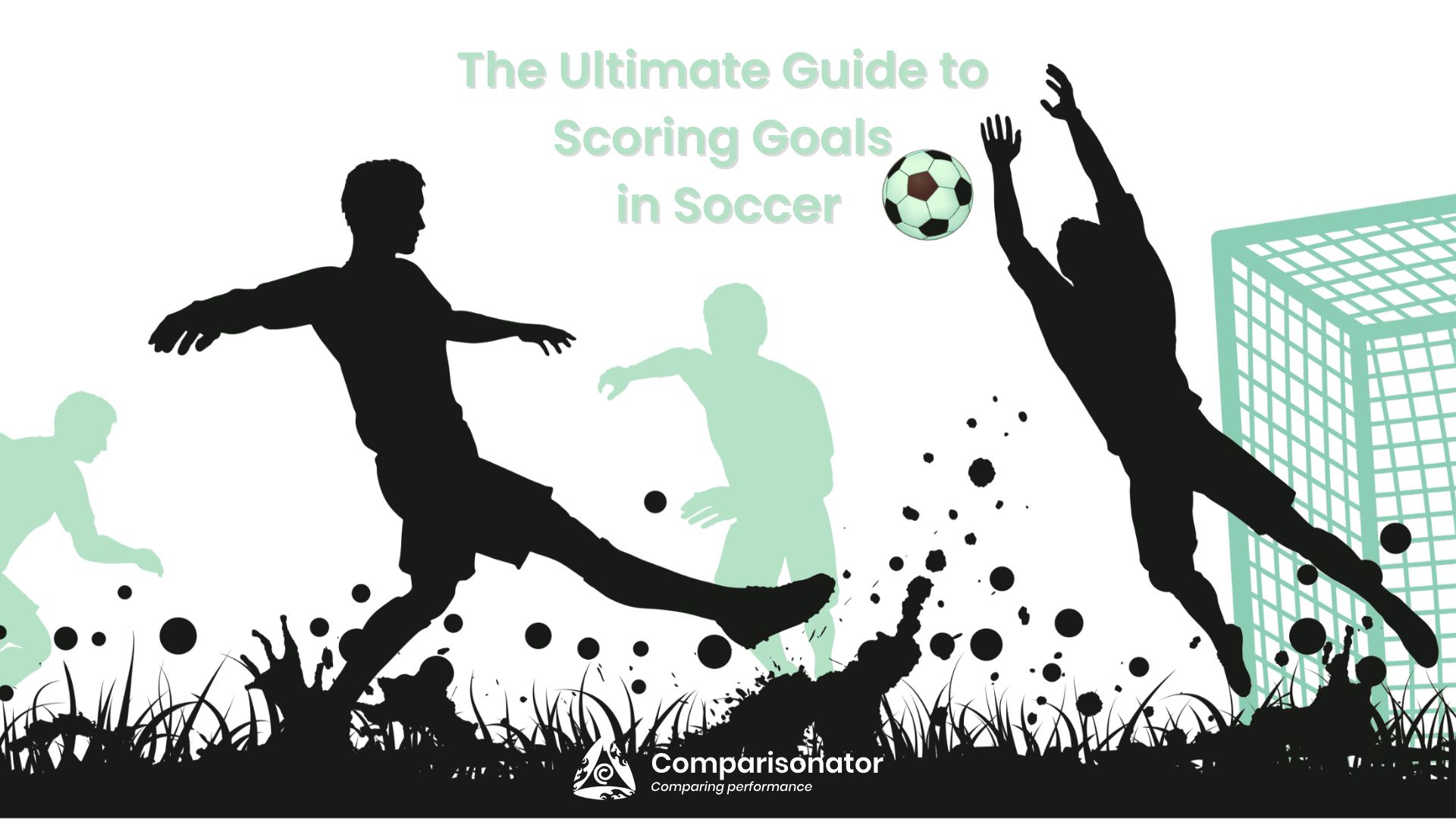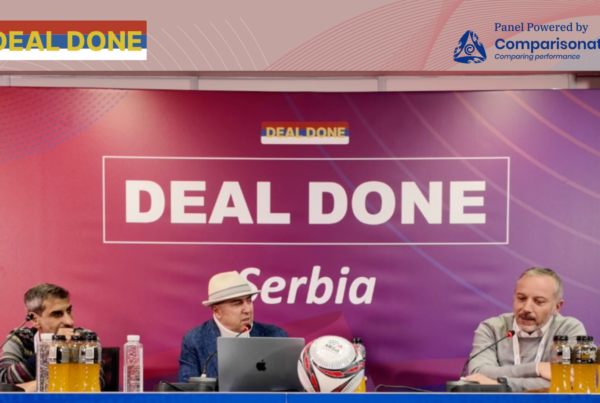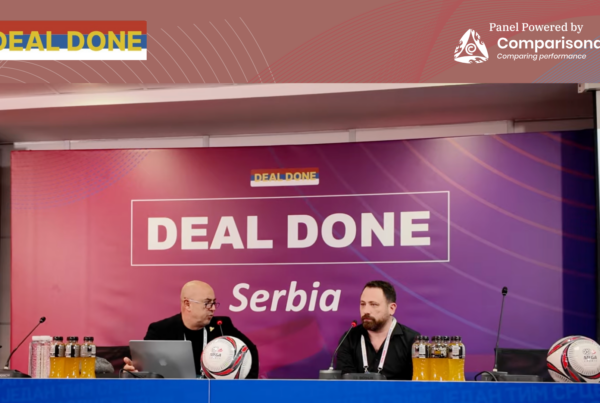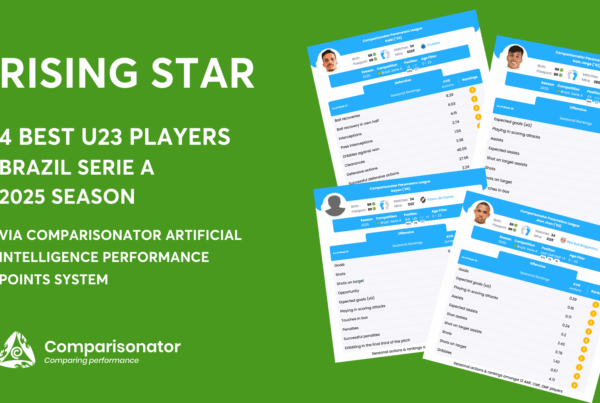Comparisonator football data platform Artificial Intelligence Points System has been upgraded with both league difficulty and player performance algorithms, making it more accurate than ever in evaluating players across different leagues. All 271 leagues worldwide now have difficulty and quality weightings. For example, a goal scored in the English Premier League is worth more than a goal scored in the Championship. In this system, 40 goals in the Championship don’t equal 20 goals in the Premier League.
Comparisonator, football data platform, using Artificial Intelligence algorithms to define player levels. We’ve also enhanced the player performance algorithm by prioritizing parameters for each position. It now uses 80-90 key parameters per position (out of a total of 300). Comparisonator football platform, calculates a goal scored by a center forward (CF) holds different value than one scored by a center back (CB). With this AI system, we can virtually transfer players between leagues, evaluate if a player’s level matches the target team, and compare them with other players in the same position to assess suitability.
Goals can be scored in multiple ways, using different techniques and body parts. Players typically shoot with their feet, but they can also score using their head, knee, chest, or even shoulder. However, scoring with the hands or arms is strictly forbidden, except for goalkeepers, who can use their hands only inside their penalty area.
Comparisonator football platform analysis some of the most common ways to score a goal include:
1. Open Play Goals in football
An open play goal is a goal scored during normal gameplay, without being the result of a set-piece such as a corner kick, free kick, or penalty. These goals are the most common in football and can be created through passing, dribbling, individual skill, or team coordination. Comparisonator football agency platform understands the suitability of player transfer.
One of the most exciting aspects of open play goals is their unpredictability. They can happen from a quick counterattack, a well-structured build-up, or a moment of brilliance from an individual player. Comparisonator football platform analysis, for example, a player might dribble past multiple defenders before scoring, or a team might string together a series of precise passes leading to a tap-in goal.
Open play goals often come from different situations on the field:
- Solo Efforts: A player dribbles past defenders and scores.
- One-Two Passes (Give-and-Go): Quick passing between teammates to break through defenses.
- Crosses into the Box: A wide player delivers a ball into the penalty area for a teammate to finish.
- Long-Range Shots: A powerful strike from outside the box.

Famous players like Lionel Messi, Cristiano Ronaldo, and Neymar have scored countless spectacular open play goals, demonstrating their technical ability and vision. These goals showcase creativity, teamwork, and individual brilliance, making them some of the most thrilling moments in football. Whether through quick movement, precision passing, or an incredible solo run, open play goals define the beauty of the sport. Comparisonator football agency platform understands the level of football player transfer.
In Comparisonator, football data platform, all 271 leagues worldwide are assigned difficulty and quality weightings to reflect their competitive levels. Comparisonator football platform analysis, for instance, a goal scored in the English Premier League carries more value than a goal in the Championship. This means that 40 goals in the Championship are not equivalent to 20 goals in the Premier League, as the system adjusts for league strength, providing a fair and data-driven player assessment.
2. Header Goals in football
A header goal is scored by striking the ball with the head, usually after a cross, corner kick, or set-piece delivery. Headers are a crucial aspect of football, allowing players to score from aerial duels, overpower defenders, and convert goal-scoring opportunities that may be difficult to finish with their feet. Comparisonator football agency platform shows the preferred foot of player.
Header goals often occur in situations where a player receives a high ball and directs it into the net. Some of the most common scenarios include:
- Crosses into the Box: A winger or full-back delivers a ball from the flank for a teammate to head into goal.
- Corner Kicks: A well-placed cross from a corner can lead to a powerful header, often scored by tall center-backs or strikers.
- Free Kicks: Set-piece deliveries allow players to rise above defenders and head the ball past the goalkeeper.
- Flicked Headers: A slight redirection with the head, often used in near-post finishes or fast-moving plays.
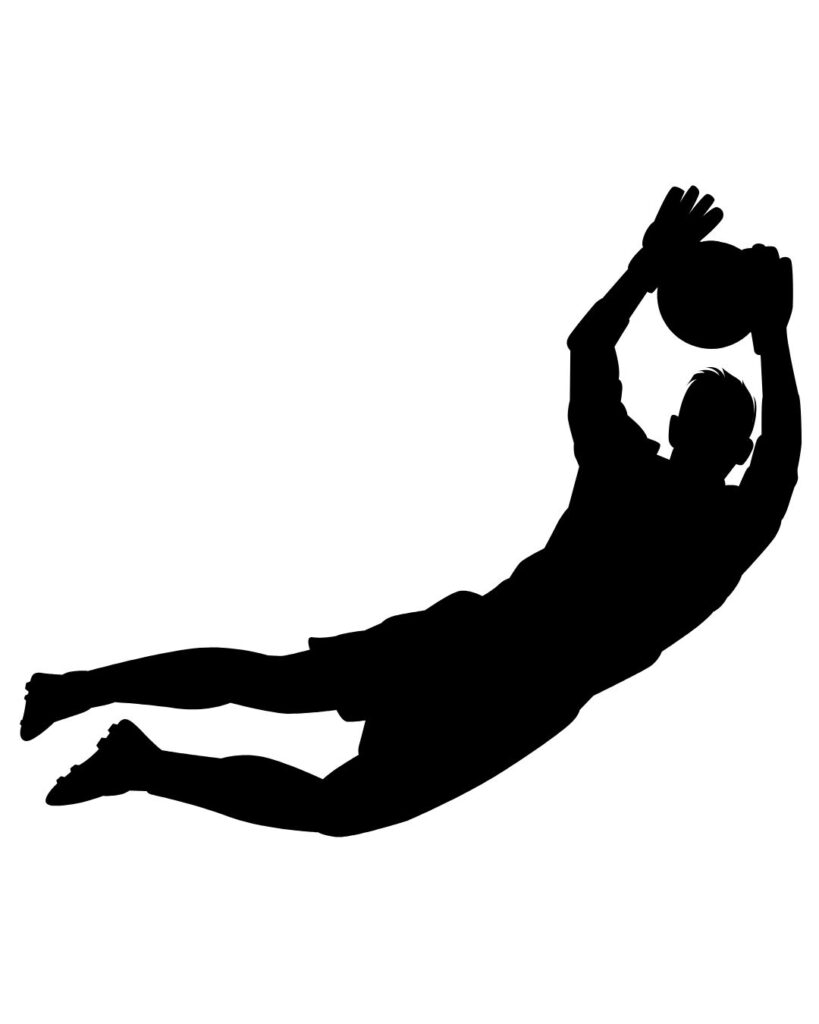
Scoring a header requires good positioning, timing, and jumping ability. Players must judge the flight of the ball, anticipate its trajectory, and make clean contact with their forehead for accuracy and power. Some of the best header scorers in history include Cristiano Ronaldo, Sergio Ramos, and Alan Shearer, who mastered the art of aerial finishing. Comparisonator football agency platform understands the finishing percentage of player in a team.
Header goals add an exciting element to the game, showcasing strength, precision, and athleticism. They often decide matches, making them one of the most impactful ways to score in football. Comparisonator football data platform utilizes the information with rankings.
10 Most Head Goal Scorers
In the calculation of Comparisonator, football data platform Artificial Intelligence pointing system, A goal scored by a center forward (CF) carries a different value than one scored by a center back (CB). With our advanced AI-driven system, we can virtually transfer players between leagues, analyze whether a player’s performance aligns with a target team’s level, and compare them with other players in the same position to assess their suitability more accurately.
According to Comparisonator football data analysis platform, this current season’s 10 most head goal scorers per 90 minutes are following: B. Zurmuhle Rivera (’09) from Switzerland U16 Elite leads the ranking with 0.63 goals per 90 minutes scored by head. Following closely, Kodjo Fo Doh Laba (’92) from Al Ain in the UAE Arabian Gulf League records 0.58 goals per 90 minutes, while Davie Selke (’95) of Hamburger SV in Germany’s 2. Bundesliga ranks third with 0.57 goals per 90 minutes.
Comparisonator football agency platform shows that in the Czech Republic 1. Liga U19, Lukas Branecky (’06) achieves 0.54 goals per 90 minutes, just ahead of Youssef En-Nesyri (’97) from Fenerbahçe in Turkey’s Süper Lig, who registers 0.52 goals per 90 minutes. Sascha Andreu (’86) from Inter Club d’Escaldes in Andorra’s 1a Divisió follows with 0.50 goals per 90 minutes, while Matheus Fornazari (’95) of Sukhothai in Thailand’s Thai League records 0.49 goals per 90 minutes. Another standout from the Czech Republic 1. Liga U19, F. Skalník (’06), manages 0.44 goals per 90 minutes. Comparisonator football platform analysis, meanwhile, Mady Camara (’97) from PAOK in Greece’s Super League contributes 0.43 goals per 90 minutes, and Alon Turgeman (’91) from Hapoel Be’er Sheva in Israel’s Ligat ha’Al rounds out the top ten with 0.42 goals per 90 minutes as Comparisonator football data analysis platform indicates.
3. Free Kick Goals in football
A free kick goal is scored from a direct or indirect free kick, often taken from outside the penalty box. Free kicks are awarded when a team commits a foul, giving the opposing side an opportunity to restart play from a fixed position. These goals are among the most spectacular in football, requiring precision, technique, and power.
There are two main types of free kicks:
- Direct Free Kicks: The taker can shoot directly at goal without the ball touching another player. These often result in stunning long-range strikes or curled shots over the defensive wall.
- Indirect Free Kicks: The ball must touch another player before a goal can be scored. These are usually used for strategic passes inside the box or powerful strikes after a short touch.

Scoring from a free kick demands exceptional skill. Players must consider the distance, angle, wall positioning, and goalkeeper’s placement before striking the ball. Some common techniques include:
- Curling Shots: A precise bend around the wall using the inside of the foot.
- Dipping Shots: A powerful shot that drops quickly, making it hard for goalkeepers to react.
- Knuckleball Shots: A strike with minimal spin, causing unpredictable movement in the air.
Legendary free-kick takers such as David Beckham, Lionel Messi, Cristiano Ronaldo, and Juninho Pernambucano have scored breathtaking goals from set-pieces. Comparisonator football platform analysis, free kicks often change the momentum of a match, making them one of the most exciting moments in football.
As Comparisonator football data analysis platform scoring from a direct free kick is a valuable skill in soccer, requiring precision, power, and technique. Comparisonator football agency platform indicates players who excel in free kicks can turn set-piece opportunities into game-changing moments. In this article, we highlight the top players based on direct free-kick goals per 90 minutes, showcasing their abilities and the leagues they represent.
Top Players in Direct Free-Kick Goals
Based on the Comparisonator football data platform, top players in Direct Free-Kick Goals Per 90 Minutes this season are following: At the top of the list is T. Mujanović (’09) from Dinamo Zagreb U16, competing in Croatia’s Prva NL Srediste. With an impressive 0.33 goals per 90 minutes, Mujanović has demonstrated exceptional accuracy and consistency in converting free-kick opportunities on the Comparisonator football data analysis platform.
Closely behind is D. Taroi (’08), who plays for UTA Arad U17 in Romania’s Superliga, recording 0.32 goals per 90 minutes. His ability to strike from set pieces has made him a key player in his team’s attacking strategy.
In third place, both Samuele Carella (’06) from Viktoria Köln U19 in the Germany U19 Bundesliga and Dino Hotic (’95) from Lech Poznań in Poland’s Ekstraklasa have registered 0.22 goals per 90 minutes. Their set-piece expertise provides their teams with an additional attacking advantage.
Other standout performers include from Comparisonator football data analysis platform:
- S. Tkachenko (’08) from Werder Bremen U17 in Germany U17 Bundesliga, scoring 0.21 goals per 90 minutes.
- Jonas Saliger (’04) from Köln II in Germany’s Regionalliga, achieving 0.19 goals per 90 minutes.
- Sosidan Nhean (’02) from Svay Rieng in Cambodia’s Cambodian League, and N. Gammelgaard (’08) from Vejle U17 in Denmark’s U17 Ligaen, both with 0.18 goals per 90 minutes.
- Lior Refaelov (’86) from Maccabi Haifa in Israel’s Ligat ha’Al, with 0.18 goals per 90 minutes.
- Petar Ristic (’00) from Trayal Kruševac in Serbia’s Prva Liga, with 0.17 goals per 90 minutes.
The Importance of Free-Kick Specialists
Free-kick goals can provide teams with an edge, especially in tight matches where opportunities from open play are limited. Players who excel in set pieces bring additional tactical advantages, often deciding crucial games. Comparisonator football agency platform gives the free-kick ability of football players.
Mastering free kicks requires a combination of:
- Technique – Proper ball contact for curl, dip, or power.
- Placement – Accuracy in targeting the top corners beyond the goalkeeper’s reach.
- Composure – The ability to stay calm under pressure and execute perfectly.
The players mentioned above have showcased their proficiency in set pieces, making them valuable assets to their teams. As they continue to develop, their contributions from dead-ball situations will remain pivotal in their respective leagues.
4. Penalty Kick Goals in football
A penalty kick is awarded when a foul is committed inside the penalty area, giving the attacking team a one-on-one opportunity against the goalkeeper. Penalty kicks are among the most high-pressure moments in football, often deciding the outcome of matches, especially in crucial games or penalty shootouts.
The penalty kick is taken from the penalty spot, which is 12 yards (11 meters) away from the goal. The goalkeeper must remain on the goal line until the ball is struck, while the shooter is allowed only one touch to score. The shooter must decide whether to rely on placement, power, or deception to beat the goalkeeper. Comparisonator football agency data platform using priority parameters for each position.

Common Penalty Kick Techniques
- Power Shot: A hard-driven shot aimed at the corners, making it difficult for the goalkeeper to save.
- Placement Shot: A precisely aimed shot into the bottom or top corner, prioritizing accuracy over power.
- Panenka: A cheeky chip down the center, executed when the goalkeeper dives early.
- Stutter Step: A hesitation in the run-up to mislead the goalkeeper before striking the ball.
Some of the greatest penalty takers in history, such as Cristiano Ronaldo, Lionel Messi, and Robert Lewandowski, have perfected the art of scoring from the spot. Penalty kicks are often decisive in tournaments, especially in penalty shootouts, where teams take turns shooting to determine the winner.
With skill, composure, and confidence, penalty kicks remain one of the most thrilling and nerve-wracking aspects of football.
5. Deflection Goals in football
A deflection goal occurs when a shot changes direction after hitting another player before entering the net. These goals can be intentional or accidental, often catching goalkeepers off guard due to the sudden change in trajectory. Deflections add an unpredictable element to the game, sometimes leading to lucky goals or crucial match-winners. Comparisonator football agency data platform gathers the most important goal parameters.
Deflection goals happen in various situations, including:
- Blocked Shots: A defender tries to stop a shot, but the ball takes an unexpected bounce into the goal.
- Own Goals: A defender unintentionally redirects the ball into their own net while attempting to clear or block a shot.
- Striker’s Touch: A forward intentionally flicks or redirects a shot to mislead the goalkeeper.
- Set-Piece Chaos: During free kicks or corners, multiple players challenge for the ball, and a slight touch can send it past the goalkeeper.
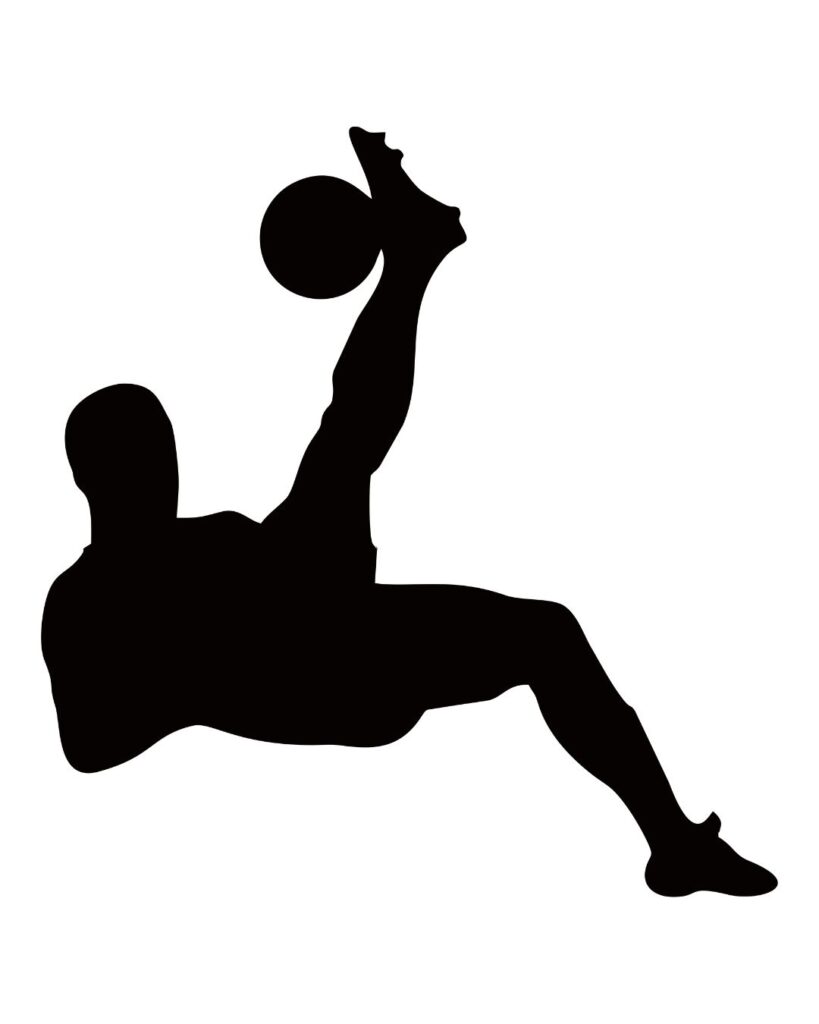
While some deflection goals result from deliberate redirections, many are purely accidental, benefiting the attacking team. For goalkeepers, these goals are frustrating, as their initial positioning becomes ineffective once the ball changes course unexpectedly.
Legendary players such as Cristiano Ronaldo, Lionel Messi, and Thierry Henry have benefited from deflections, turning ordinary shots into unstoppable goals. However, defenders also use deflections to their advantage by blocking shots to prevent clear scoring chances. Comparisonator football agency data platform has scoring parameters as scouting platform.
Ultimately, deflection goals highlight football’s unpredictability, where even the slightest touch can change the course of a match.
